Bhendi, or Okra, is one of India’s most commonly consumed vegetables. The edible seed pods of Okra are grown as an annual herbaceous plant in the Malvaceae family. Plants of the okra family have small, erect stems with heart-shaped leaves that can be bristly or hairless. Leaves measure 10–20 cm (4–8 in) long and have 5–7 lobes. Flowers have five petals ranging in color from white to yellow and measuring between 1.6 and 3.1 inches wide.
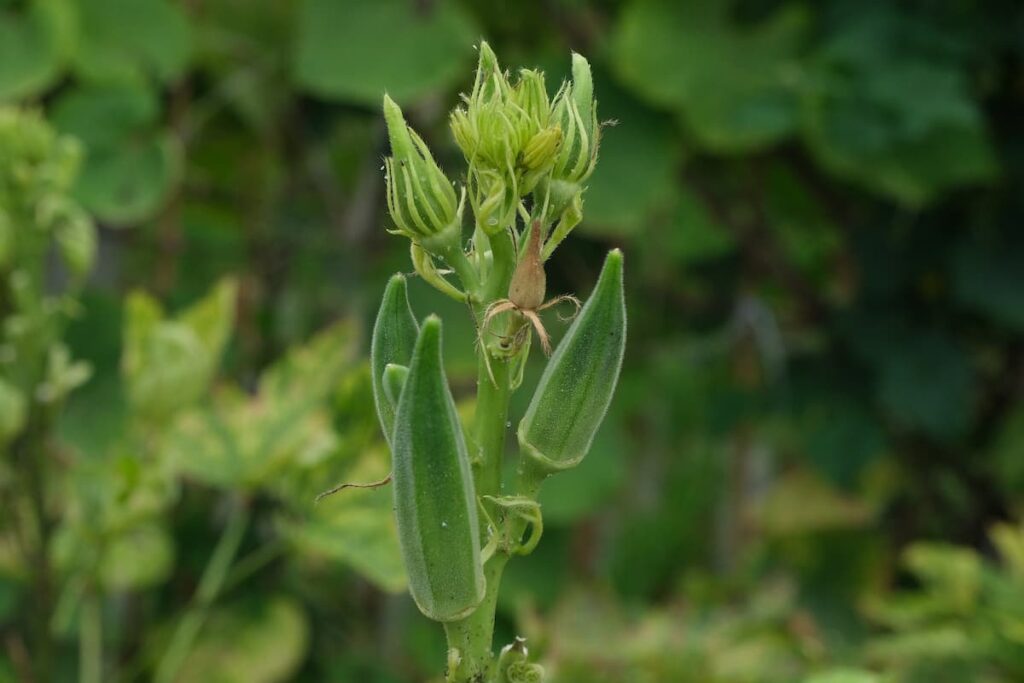
Seed pods measure up to 25 cm (10 in) long and contain many seeds. As an annual plant, Okra grows between 1.2 and 1.8 meters (4 and 6 feet) tall. Ethiopia is believed to have been the origin of Okra. Unfortunately, various diseases and pests affect the okra crop, significantly reducing quality and yield. Here is a list of common diseases and pests associated with Okra cultivation.
Pest and disease management in okra
Major pests in Okra or Bhendi crops
Shoot and fruit borer
Identification of the pest
During the night, the female moth lays 200-400 eggs on tender leaves and buds of Okra. Eggs are sky blue. After hatching, the caterpillar passes through six stages and becomes full-grown in 10-16 days. Moths emerge within 8-14 days after pupating on the plants, outside the infested fruit, or on the ground in a boat-shaped cocoon among fallen leaves. It takes 17-29 days for the entire life cycle to be completed. The forewings of these moths measure about 2.5 cm across and have a narrow, longitudinal green band. A full-grown dull-green caterpillar has a stout body, longitudinal black spots, and tiny stout bristles.
Damage symptoms
- Larvae bore into tender terminal shoots during the vegetative stage, and flower buds, flowers, and young fruits during the fruit formation stage.
- Drooping, withering, and drying occur in damaged shoots.
- Infested fruits have a deformed appearance and are unfit for consumption. Therefore, the boreholes are plugged with excreta.
Biological control
- Release of the egg parasite T chilonis and the larval parasite Chelonus blackburnii
- Release 40,000 larvae of Chrysoperla carnea at first instar.
- Place five light traps per acre to monitor the moths and their egg-laying
- Set up two pheromone traps per acre
- Pheromone trap at 1 for 400 sq.m. + weekly release of 50,000 to 60,000 Trichogramma chilonis + two sprays of BT at 1ml/L at ten days intervals at peak flowering.a
Chemical control and management:
- Remove infested fruits and shoots regularly and bury them deeply.
- The pest can be effectively controlled by spraying with quinalphos 25 EC (2 ml/liter of water) or carbaryl (4 g/liter of water). Spraying should be carried out only after all affected parts of the plant have been removed.
- Spray carbaryl 50% WP 1 kg or endosulfan 35 EC or monocrotophos 36 WSC 1.0 L.
- NSKE 5% or Azadirachtin 5% 400 ml or Fenpropathrin 30 EC 250-340 ml or Pyridalyl 10 EC 200-300 ml with 200 L to 300 L water/acre.
In case you missed it: Nutritional Deficiencies in Tomato Crop: How to Fix, Solutions, and Treatment
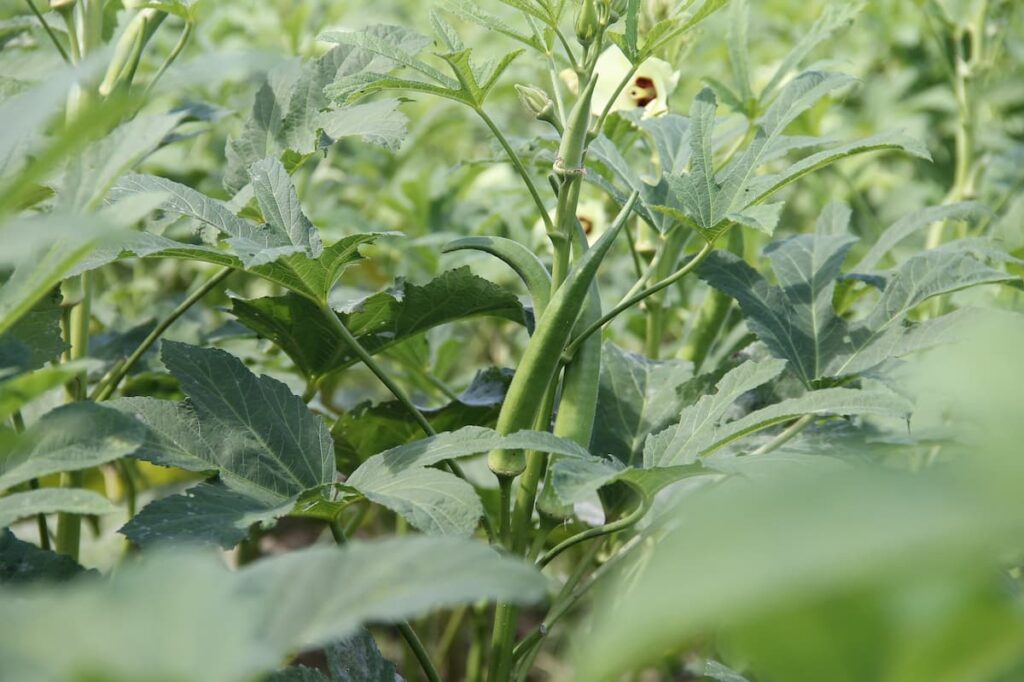
Okra fruit borer
Identification of the pest
Plant tender parts are where the female lays her eggs singly. During 4-7 days, an adult female can lay 300-500 eggs. The eggs are spherical and creamy white, laid singly. It takes 3-6 days for eggs to hatch. It takes 13-18 days for the larva to develop. The larva’s color varies from greenish to brown. In the soil, the full-grown larva pupates. It takes 8-15 days for a pup to develop. Afterward, the pupa turns brown and appears in soil, leaves, and pods. The adult female appears to be a brownish-yellow stout moth, while the male appears to be a pale greenish moth.
Damage symptoms
- The young larvae on hatching feed on foliage for some time and later bore into the fruits with their bodies hanging outside.
- Feed on the flowers and circular boreholes on fruits
- Larva thrust only part of their body inside the fruit feed
Biological control
- Setup pheromone trap with Helilure at 15/ha
- Six releases of T. chilonis at 50,000/ha per week coinciding with flowering time
- Release Chrysoperla carnea at the weekly interval at 50,000 eggs or grubs/ha from 30 DAS
Chemical control and management
- Collect and destroy the infected fruits and grown-up larvae
- Use carbaryl 50WP 2 g/lit, profenophos 0.05 percent, or Bacillus thuringiensis variants.
- Apply nuclear polyhedrosis virus (HaNPV) at 100-200 larval equivalent/acre.
- Do not spray insecticides after the maturity of fruits.
Leaf roller
Identification of the pest
200-300 eggs are laid by the female moth on the underside of the leaves. Eggs are incubated for two to six days. Larval development takes 15-35 days. The pupae develop on the plant, inside the rolled leaves, or among soil debris. Pupae last for 6-12 days. Adults live for a week. It takes 23-53 days for the life cycle to complete. Yellowish-white moths with black and brown spots on their heads and thoraxes. Dark brown wavy lines run along the wings of these insects, which measure about 28-40 mm across.
Damage symptoms
- It feeds on the leaves of the okra plant.
- A severe infestation may result in the complete defoliation of the plants.
- The chlorophyll content is scraped and fed inside
- In young larvae, the lower epidermis of leaves is fed upon, while in older larvae, the edges of the leaves are rolled up to the midrib.
Biological control
- Conserve natural enemies, which often keep leafroller populations low. For example, parasitic wasps and tachinid flies are especially common in leafroller larvae and pupae.
- Trichogramma parasites kill some eggs. Assassin bugs, green lacewing larvae, ground beetles, and certain other beetles and spiders are common predators of leafrollers
Chemical control and management
- The control measures adopted for shoot and fruit borer will also take care of leaf roller infestations. The first step is to collect rolled leaves and destroy them. The second step is to spray carbaryl 50 WP 400 grams or phosalone 50 EC 400 ml in 200 liters of water per acre.
- Pyrethroids, cypermethrin, and indoxacarb (or a mixture of these active ingredients) have been used successfully to reduce infestation levels.
In case you missed it: How to Grow Super Napier Grass: A Guide to Planting to Harvesting
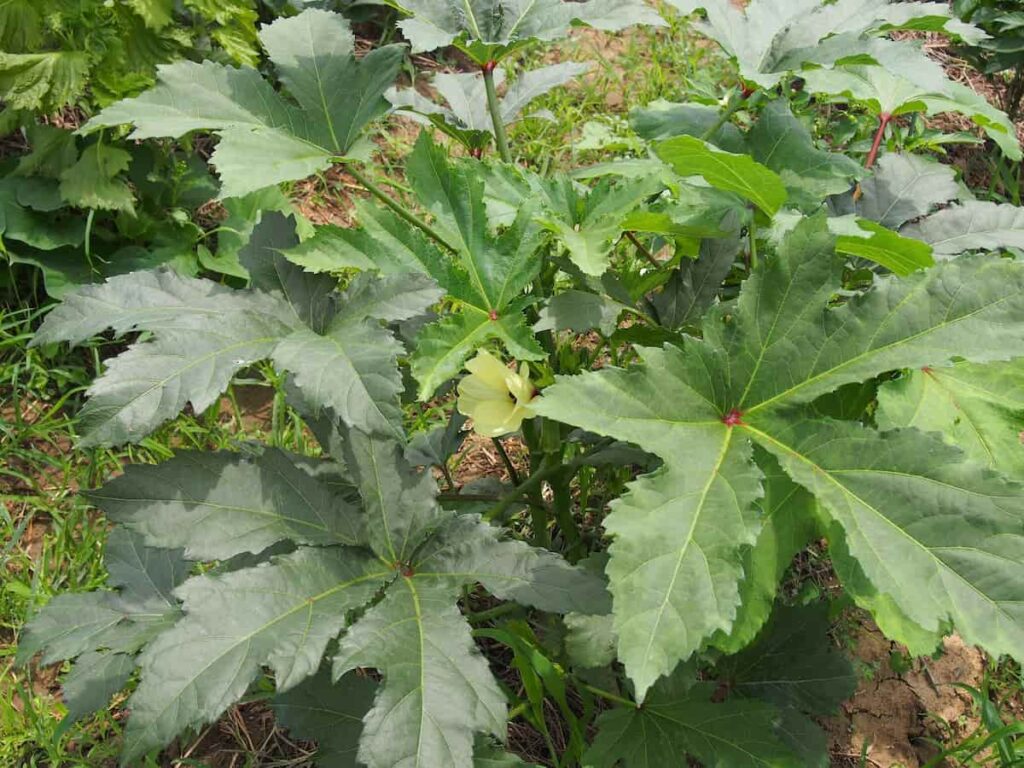
Blister beetle
Identification of the pest
It is estimated that each female lays between 100 and 2000 eggs, depending on the quality of the food she consumes. Soil is usually where the eggs are laid. When the grub hatches, it feeds on soil-dwelling insects, including pests, without causing crop damage. Several larval forms are present in the grubs, with several instars. Because of its three-clawed legs, the mobile-first instar grub is called a triungulin. Later in the life cycle, it becomes less active and pupates. Approximately 2.0-2.5 cm in length, the adult bears alternating black and red bands on the forewing (elytra).
Damage symptoms
- The adult is in the destructive stage. As the insects feed on the plant’s reproductive parts, they can cause significant yield losses.
- The adult blister beetle primarily feeds on flowers. However, feeding damage can also be found on tender leaves and shoots.
- The beetles often attack fruits but generally in small patches within the field. They usually do not continue feeding for long before moving elsewhere.
Chemical control Management
- Spray thiodicarb 0.09 percent controls the pest.
- Ha NPV 3 x1012 POB/ha in 0.1% teepol
- Apply any one of the following insecticides:
- Azadirachtin 0.03%WSP 1-2 kg/acre
- Bacillus thuringiensis serovar kurstaki (3a,3b,3c) 5%WP 400- 500 g/acre
- Emamectin benzoate 5%SG 100 g/acre
- Indoxacarb 15.8%SC 130 ml/acre
- Quinalphos 25%EC 550 ml/acre
- Spinosad 45%SC 50-60 ml/acre
Solenopsis mealybug
Identification of the pest
A female lays 300-700 eggs, usually in an ovisac beneath her body. The eggs hatch in a few minutes to 2 days. The newly emerged nymphs (crawlers) crawl out and start feeding on tender parts of plants. The female mealy bug passes through three nymphal instars in 12-17 days. The male mealy bug passes through four nymphal instars in 14-18 days. The longevity of adult females is longer (14-19 days) as compared to the male, who is shorter (1-3 days).
Damage symptoms
- A nymph and an adult may be sucking the sap from leaves, flower buds, petioles, twigs, fruits, and stems of the plants they eat.
- The insect heavily sucks the sap from the plant, rendering it weak, feeble, and dehydrated. In severe cases development of sooty mold takes on honeydew produced by mealy bugs.
- The sooty mold reduces the photosynthetic ability of the plants. In addition, the fruits infested with mealy bugs reduce the marketability of the fruit.
Biological control
- The hymenopterous parasitoid, Aenasius bambawalei, is very effective against the mealybug; as high as 70-80 percent parasitization has been reported in certain areas.
- Naturally occurring predators of mealybugs include lady beetles, green and brown lacewings, spiders, minute pirate bugs, and larvae of predaceous midges.
- The mealybug destroyer lady beetle, Cryptolaemus montrouzieri, is the most important of these predators in many areas.
Chemical control and management
- In case of severe infestation, spray 1.25 liters of profenophos 50EC or 2.0 liters of quinalphos 25EC, or 625 g of thiodicarb 75WP in 500 liters of water.
- The spray of profenophos 40 % + cypermethrin 4 % EC gives good results.
- Applying insecticidal soaps, horticultural oil, or neem oil insecticides directly on mealybugs can provide some suppression. However, test the materials for phytotoxicity before application.
- Avoid spray of insecticides if parasitized mealy bug mummies are observed.
In case you missed it: Key Rules for Home Gardening in India
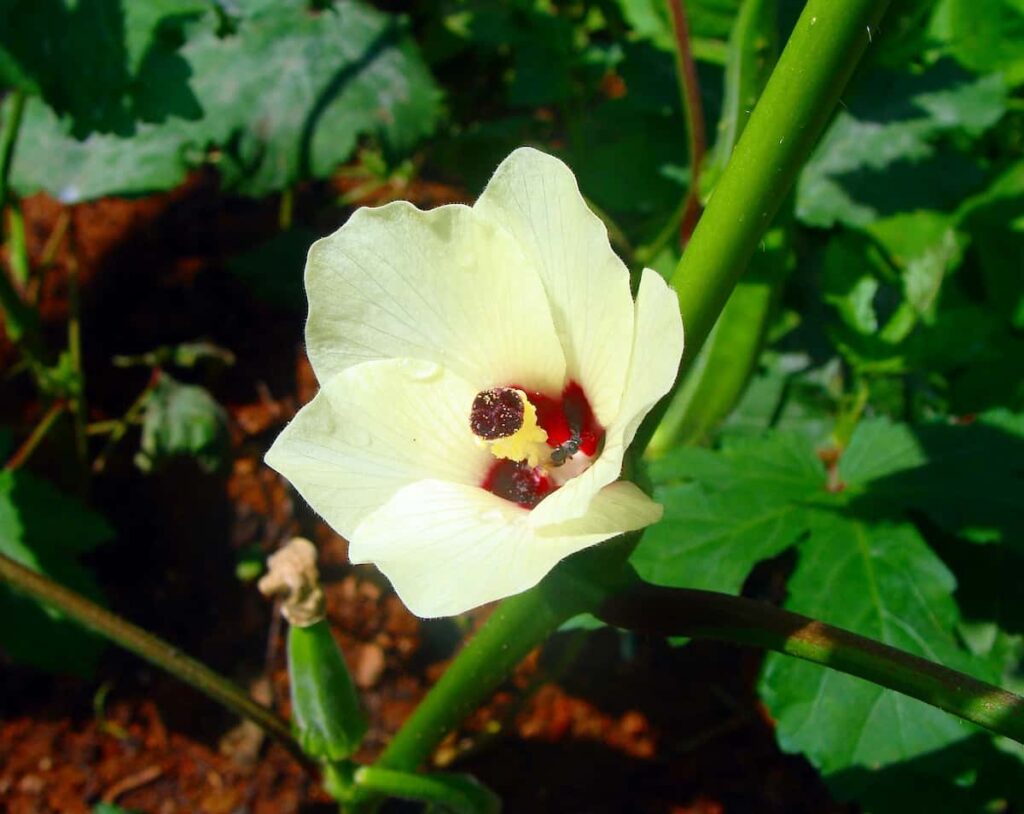
Diseases in Okra
Yellow Vein Mosaic
Yellow vein mosaic of bhindi (Okra) is caused by Bhendi Yellow Vein Mosaic Virus (BYVMV). BYVMV is a monopartite begomovirus that belongs to the family Geminiviridae. Geminiviruses are plant viruses usually comprising two similar-sized DNA components (DNA A and DNA B) for encoding various proteins.
BYVMV are transmitted by whitefly (Bemisia tabaci) belonging to the Aleyrodidae of Hemiptera. This disease was first reported in 1924 by Kulkarni from Bombay, India. The disease is cosmopolitan in distribution and reported from everywhere the crop is grown. The disease is extensively reported in India and Sri Lanka.
Damage symptoms
- A characteristic symptom of the disease is the yellowing of the entire vein network in the leaf blade. In addition, it is common for the younger leaves of the plant to turn yellow, become smaller, and become stunted in severe infections.
- As the virus spreads, the veins of the leaves will be removed, and the interveinal area will turn yellow or white.
- The disease can attack any stage of a plant’s growth in a field and begin at any time.
- Flowers are fewer and smaller when infected, and fruits may be harder and smaller if they form.
- It produces fruits that are yellow or white, and they cannot be sold.
Chemical control and management
- Spray azadirachtin 0.03 WSP at 5g per 10l or methyl demeton 25 EC at 1.6 ml/l or thiamethoxam 25 WG at 2 g per lit to kill the insect vector, whitefly.
- It is possible to minimize the incidence of yellow vein mosaic by selecting varieties such as Parbhani Kranti, Arka Abhay, Arka Anamika, and Varsha Uphar resistant to the disease.
- For sowing during the summer season, the susceptible varieties should be avoided when the whitefly activity is high.
- Spraying monocrotophos 1.5 ml/liter of water can restrict the disease’s spread.
- Synthetic pyrethroids should not be used because they will aggravate the situation.
- It can be controlled by applying Chlorpyriphos 2.5 ml + neem oil 2 ml lit of water.
In case you missed it: Best Practices to Grow Okra at Home: Check How this Guide Helps Beginners
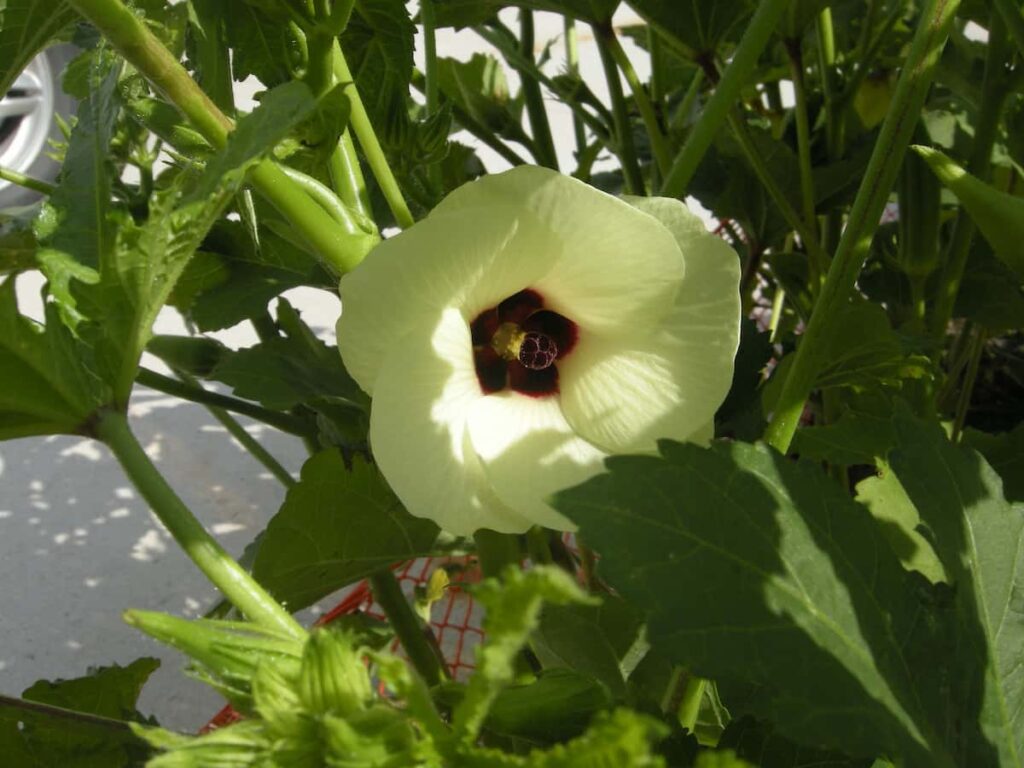
Rhizoctonia rot
The fungus Rhizoctonia solani causes Rhizoctonia root rot. This fungus is found in most soils as a sclerotia (a very resistant fungal survival structure). Usually, the damage is more prevalent on south-facing hillsides with warm, moist sandy soils. In addition, plants are more likely to contract this disease if their soil is well-drained and stressed.
Damage symptoms
- An infected pod is greenish, turning brown, and fully covered in mycelia
- The diseased tissues were light brown to black on the inside of immature seeds and placentas
- Mycelia form a large number of dark sclerotia on the surface of fruits, which are fluffy and lighter in color
Chemical control and management
- Avoiding contact with soil as it often is a source of Rhizoctonia.
- Water in the morning to allow leaves and stems to dry before sunset.
- Increase airflow within the plant canopy.
- Increase plant spacing to allow humidity to escape the plant canopy and try to maintain humidity levels below 93%.
- Avoid plant stress and prevent injury, which can create open wounds that serve as entry points for Rhizoctonia.
- Grow plants at 12 °C or colder. Remember, this provides ideal conditions for other root disease organisms.
- Plant debris from previous crops should be removed before planting
- Quintozene – sprayed in the soil before sowing-effective control
- Seed treatments containing a strobilurin fungicide can be used to manage this disease.
Fusarium wilt
This disease reaches okras through a fungal plant pathogen. It is found in the soil and enters the plant through its root system. Once it attacks a plant, it will suffer many effects, but the most noticeable is that it will begin to wilt. Therefore, it must be destroyed as soon as a plant suffers from fusarium wilt’s effects. Since this pathogen thrives in high-humidity environments, it is best controlled by watering under control and planting in well-drained soil.
Damage symptoms
- The conspicuous symptom is typical wilt, beginning with yellowing and stunting of the plant, followed by wilting and rolling of the leaves as if the roots were unable to supply sufficient water.
- Finally, the plant dies.
- If a diseased stem is split lengthwise, the vascular bundles appear dark streaks.
- When severely infected, nearly the whole stem is blackened.
Chemical control management
- Treat the seeds with Mancozeb at 3g/kg seed.
- Drench the field with Copper oxychloride at 0.25%
Powdery mildew
The disease is found mainly on the older leaves and stems of plants. Yields of many of the infected vegetables are reduced due to premature foliage loss. In addition, increased humidity can increase the severity of the disease, and infection is enhanced during periods of heavy dew.
Damage symptoms
- Powdery mildew is very severe on Bhendi.
- Greyish powdery growth occurs on the under as well as on the upper surface of the leaf, causing a severe reduction in fruit yield.
Chemical control management
- Dustsulphur at 25kg/ ha or spray dinocap at 2ml/l
- carbendazim at 1g/l or wettable sulfur at 2 g / l or triademephon at 0. 5g/l immediately after noticing the disease and repeat after 15 days if necessary.
- Spray inorganic sulfur 0.25% or Dinocap 0.1% 3 or 4 times at 15 days intervals.
In case you missed it: How to Grow Okra Plants Faster: Best Tips to Increase Flowering, Fruiting, and Yield

Leafspot of Okra
The leaf spots are caused by the fungus Pseudocercospora abelmoschi. It survives and overwinters on infected plant debris in the soil and thus infects the roots and lower leaves of the Okra plants. The spores are spread secondary via wind, rain, irrigation, and mechanical tools. Leaf spots are very common during the humid season (flowering stage), as the fungi favor warm and wet weather.
Damage symptoms
- Initially, indistinct olive-colored spots can be observed on the lower side of the leaves. Then, especially older leaves, which are closer to the ground, are affected by the disease.
- Light brown to grey moldy fungal growth may develop on affected leaf surfaces. As the disease progresses, spots become necrotic and can also appear on the upper leaf surface.
- Infected leaves eventually become dry and wither. Stem and fruit may also be affected by similar symptoms. Under severe infestation, the plant might defoliate completely.
Chemical control and management
- Spray fungicide on the lower side of the leaves in the afternoon. Use protective fungicides such as copper oxychloride at 0.3%, Mancozeb at 0.25%, or Zineb at 0.2% a month after sowing and repeat this procedure at fortnightly intervals, depending on severity.
- Carbendazim 50 DF at 0.1% at 15 days intervals also showed promising results in controlling the disease.
Okra Root Knot Nematodes
The hot summers that Okra thrives in are ideal for root-knot nematodes, which are highly susceptible to root-knot nematodes. The root-knot nematode is a tiny eelworm that lives in the soil and parasitizes plants when it uses okra roots as a nursery. It is common for nematodes to enter okra roots through small wounds. In addition, when feeder roots multiply in number, irregular galls replace them, destroying small feeder roots.
Damage symptoms
- The plants grow slowly, in bursts of erratic growth, and are generally dwarfed.
- Several swellings and galls can be seen on the roots of an okra plant in trouble.
- Root-knot nematodes cannot travel far in the soil without human assistance, so neighboring plants may be infected while those at the end of the row remain unaffected.
Chemical control and management
- Avoid monocropping and follow crop rotation.
- Before sowing, do seed treatment with Carbendazim at 2.5 grams per kg. Then, drench the soil with Carbendazim solution at 1gm/Ltr of water.
- Only seedlings with roots free of galls should be selected for transplanting.
- Apply Pseudomonas fluorescens at 10g/m2 in a nursery.
- Crop rotation with non-hosts or resistant crops.
- Proper weed control and destroy galled roots after harvest.
- Soil solarization with clear plastic traps during summer.
- Use of resistant cultivars.
- Application of carbofuran 3G at 1kga.i./ha.
Conclusion
Compared to other countries in the world, the productivity of Okra in India is very low due to yield losses caused by insect pests, diseases, and nematodes that cause yield losses in the harvest. It is estimated that more than 72 insect pests attack the crop, from seedlings to harvesting and that they are active at every stage of the crop’s life cycle. Therefore, if you control these pests, you can save your crop.
- Budget Friendly Sheep Shed Ideas: Cheap and Low-Cost Tips
- How Much Do Cattle Farmers Make: Revenue Streams in Cattle Farming
- Management Pests and Diseases in Your Cotton Field
- Sheep Farming Business Plan for Beginners
- Aquaponic Farming at Home: A Step-By-Step Guide
- Profitable Village Farming Business Ideas in 2024
- High-Yield Aquaculture: Fast-Growing Fish for Farming
- Effective Fish Pond Construction Techniques for Beginners
- Irrigation and Water Management in Pineapple Farming
- Blossom to Harvest: Mastering Flowering and Pollination in Papaya Farming
- Pig Fattening Essentials: From Selection to Sale for Beginners
- Raising Wagyu Cattle: A Complete Guide for Premium Beef Production
- Soil Types and Their Water Holding Capacity
- Optimizing Irrigation Schedules for Coconut Groves for Enhanced Yield
- Espresso Your Garden: Coffee Grounds for Healthier Acid-Loving Plants
- The Best Soil Mix for Snake Plants: How to Mix Your Own Snake Plant Soil
- Green Thumb Success: Expert Tips for Cultivating Greenhouse Beans All Year Round
- Bloom All Year Round: The Ultimate Guide to Indoor Hyacinth Care
- Eco-Friendly Gardening: How to Make Liquid Fertilizer from Kitchen Waste
- Ultimate Guide to Grow Anise in Pots: Explore Seed Propagation to Harvesting
- Guide to Raising Chester White Pigs: Discover Breed Facts to Growth Management
- Mastering the Elegance: The Ultimate Guide to Weeping Cherry Tree Care, Planting, and Maintenance
- Ultimate Guide to Planting Garlic in Grow Bags: Growing Strategies for Beginners
- How to Fix Spider Plant Leaf-Related Problems: Natural and Organic Remedies
- 10 Reasons Why Your Tulsi Plant is Shedding Leaves: Home Remedies and Solutions
- Optimizing Growth and Yield: The Advantages of Palm Bunch Ash Fertilizer
- Utilizing Neem Oil Extract as a Natural Pesticide for Hydrangea
- From Soil to Harvest: Various Ways in Which Farmers Can Use AI Tools
- Steps to Encourage and Induce Citrus Flowers: A Comprehensive Guide
- How to Fix Snake Plant Leaf-Related Issues: Natural and Organic Remedies
- Transform Your Garden into a Fragrant Oasis with Raat Ki Rani (Night Blooming Jasmine)
- Discover the Ideal Chicken Breeds for Philippine Farms
- How to Create a Poultry Egg Farm Business Plan for Profits
- Grow Lemon Cucumbers Like a Pro: Insider Techniques for Bountiful Yields
- Ultimate Guide to Caring for Your Pink Princess Philodendron: Tips for Thriving Variegation
- Areca Nut Profit Per Acre: Calculating Yield and Cost of Cultivation
